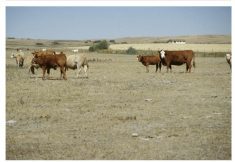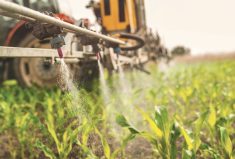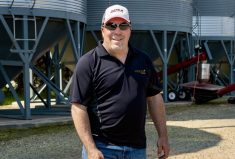There’s been a surge in the number of farmers seeking cash advances thanks to soaring interest rates and a big increase in the interest-free portion of the loan.
And the deal might even be tempting farmers who don’t need an operating loan.
On April 3, the opening day of the 2023 program, the Canadian Canola Growers Association issued over $300 million in cash advances to more than 1,500 farmers. This was an all-time record for the association, the largest of the 30 organizations administering the Advance Payments Program.
Read Also

Moo translator and methane measures: There’s an app for that
Dalhousie University researchers use artificial intelligence to create new dairy farm apps that analyze cattle sounds and measure methane.
And things haven’t slowed down since.
“We’ve already got 5,000 applications in our hands getting processed or paid already,” Dave Gallant, director of the association’s program, said on May 1. “We are well ahead of last year in terms of number of advances in process this time of year.”
And all that’s before the interest-free portion rises to $350,000. (Farmers can borrow up to $1 million in total if they have sufficient commodities to pledge against the loan.)
As of early May, Gallant didn’t know when the interest-free portion would be increased, but said it should be soon.
“We were told after the budget was announced March 28 that it could take anywhere from eight to 10 weeks,” he said. “I would suspect we’d be looking at some time in May or early June.”
A jump in bank prime rates is a big driver.
“The cost of financing for farmers has gone up significantly in the last 12 months with interest rates moving from 2.45 per cent to 6.7 per cent in terms of prime rate,” he said.
So should a farmer take out an interest-free loan even if they don’t need it?
Yes, farmer and ag journalist Kevin Hursh said in a recent column in The Western Producer. He noted a $350,000 loan invested in a six-month GIC with a three per cent interest rate would yield more than $5,000.
“Should someone who doesn’t need an operating loan feel bad about taking the interest-free money?” wrote Hursh. “Not at all. Just don’t let it encourage you to make purchases you otherwise wouldn’t.”

Farmers can take out a cash advance for pretty much anything. But while the terms are flexible, the loan has to be repaid in a timely manner. Repayments are tied to commodities pledged against the loan — 18 months for crops and 24 months for cattle and bison.
“The fundamental rule is no matter how you use the funds, you still have to repay your cash advance as you sell your inventory,” said Gallant.
“Let’s say you have 1,000 tonnes of canola that you take your advance out on. You are legally obligated to repay as you sell the canola. You can’t hold onto the funds for 18 months unless you’re not going to sell until 18 months down the road.”
Program administrators can’t tell applicants what they can do with the money, added Jason Lenz, chair of FarmCash, the cash advance administrator run by Alberta Wheat and Alberta Barley.
“Every farm is going to be a little bit different and if there are individuals (investing their loans) I would trust they’re doing it for the best benefit of their farming operations.”
The interest-free portion of the loan used to be $100,000 but that was upped to $250,000 last year because the cost of inputs and other farm expenses had risen so much. That was also the reason for increasing it again this year.
“In this year’s budget, the government was looking to help farmers reduce the overall cost of financing on their farms, understanding that most farmers are heavily leveraged in terms of production and as a result that increase in cost is affecting the bottom line,” said Gallant.
Value of collateral increases
Producers should also be aware of another change in this year’s program.
“Last year the (agriculture) minister allowed us to issue 100 per cent of the funds to farmers right away,” said Gallant. “This year we’re back to the normal rules where you can get 60 per cent of the funds up front and 40 per cent once you finish seeding.”
The security of the loan is based on the crop the farmer decides to grow. It’s calculated based on up to 50 per cent of the anticipated market value of the crop the producer is growing or storing. This is good news for canola, wheat and cattle producers — all three commodities have seen rates rise in 2023.
“Canola went from $363.75 per tonne in 2022 to $397.70 per tonne,” said Gallant. “That’s a nine per cent increase. Wheat went up 20 per cent. Those are two of the biggest products in the program that farmers take advances on and as a result farmers are eligible to receive more funds.”
That makes a cash advance a good deal compared to a conventional loan.
“Say a farmer takes out half-a-million dollars from the program with $250,000 interest-free at prime minus three-quarters of a percent,” he said. “If that farmer was to borrow the same amount from his bank or credit union at prime plus a half, the cash advance is going to save them $20,000.”
Another good reason to apply, he said, is the program’s limited collateral requirements, which may be particularly attractive to young farmers who don’t own land.
“The cash advance only requires you to own your inventory,” said Gallant.
The intent of the program is to give producers financial breathing space so they don’t have to sell just because bills are due.
“What a lot of our customers will do is take an advance based on what they’ve harvested and they will use those funds to carry them through the winter until the market price is where they want it to be,” said Gallant.
They can also buy inputs or other supplies when prices are favourable, said Lenz.
“If you have an opportunity to buy inputs at a reduced price, whether they’re on sale or just at a price you’d like to buy them at, it’s nice to have that extra cash flow from the Advance Payments Program to give you that ability,” he said.
FarmCash is also seeing more applications this year. About 200 were received in April, prompting the cereal commissions to hire additional support staff.
On April 26, Alberta Wheat and Alberta Barley abruptly dismissed its senior management, including the FarmCash program manager, general manager Tom Steve and chief operating officer Syeda Khurram. However, applicants don’t need to worry about the status of their applications, said Lenz.
“We’re well on our way to making sure that all of our services continue as normal,” he said. “We just need to hire some more people to help us get all of these FarmCash applications (processed).”
A list of cash advance administrators, as well as their administration fees and rates on the interest-bearing portion of the loans, can be found at the Advance Payments Program page at the Government of Canada website.
















